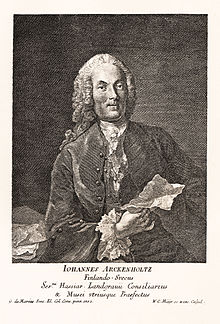Johan Arckenholtz
Johan Arckenholtz (born February 9, 1695 in Helsinki , † July 12, 1777 in Stockholm ) was a Finnish librarian, political pamphleteer and historian working in Sweden. He is best known as the author of a story about Christina of Sweden .
Life
Johan Arckenholtz was born in Helsinki as the son of a municipal lawyer . His paternal great-grandfather was a fur maker and immigrated from Germany during the Thirty Years War . His mother was Helena Forssenius, of Swedish descent.
Arckenholtz began to study law and history at the University of Turku (the Swedish-speaking university in Finland), but in 1713, fleeing from the Russian troops who occupied what was then Sweden in the Great Northern War , went to Sweden, where he lived in Uppsala continued his studies. There he was particularly influenced by the teachings of Samuel Pufendorf . Stays abroad took him to the universities in Marburg (where he heard Christian Wolff ), Utrecht , Strasbourg and a year in Paris . From 1718 he was a member of the royal court chancellery in Stockholm (which also functioned as the foreign ministry), where he became registrar in 1735 . The years from 1720 to 1732, however, he mainly spent abroad, where, as was customary at the time, he accompanied young Swedish nobles as a tutor on their grand tour of Europe and also undertook history studies. In 1731 he visited England and wrote about it in letters to his French friend, Abbé Bouqueron.
At that time Sweden was the only country in Europe besides England to have a parliamentary democracy, with the Hats Party (Hattarne), which stood for a connection with France and a policy of revenge against Russia, and the Hats Party (Mössarna) opposed, with the latter opposed started another war with Russia and for a closer connection with England. Arckenholtz was a supporter of the government under Arvid Horn , who was supported by the hat party. In a memorandum on Sweden's foreign policy, which was only intended for his political friends, he made fun of the French Foreign Minister Fleury and sharply attacked him. The writing came to the attention of the leaders of the Hat Party, who saw an occasion to get Horn in trouble and brought the writing to the attention of Fleury, who was angry with him.
After the Hat Party came to power, this led to Arckenholtz's dismissal in 1738. Arckenholtz became a staunch political opponent of the hat party and worked during the Reichstag in 1740/41 for the hat party, for which he was in the manufacture office of the Ministry of Commerce. As part of a political intrigue by the Hat Party, he was imprisoned with several others in February 1741 and sentenced to indefinite imprisonment in Bohus Fortress . After changing the ruling party at the next Reichstag, he was released in March 1743 and went abroad.
In 1746 he became Hessian librarian and councilor for King Friedrich I in Kassel , which he stayed with his brother, Landgrave Wilhelm VIII (Hesse-Kassel) even after his death in 1751 . During this time he became known for his story about Queen Christine of Sweden , which appeared in four volumes from 1751 to 1760 (Memoires concernant Christine, Reine de Suède) and contained extensive source material, which he found in Rome, the last residence of the former Queen, and in the Vatican . Because of the sources printed, the work is still valuable to historians today. At that time it led to a literary feud with the Dane Ludvig Holberg when he belittled Christine of Sweden.
After the hat party lost power, he returned to Sweden in 1766 and was commissioned by the Swedish King Adolf Friedrich to write a story of Frederick I, which he did not complete. In addition to his biography of Christina of Sweden, Arckenholtz wrote a few smaller works, for example in 1734 and 1739 against the trade policy of the Hat Party, in particular against the privileges granted by it to the newly founded Swedish East India Company . His extensive collection of material for a story of Gustav Adolf was later used by the historian Jakob Mauvillon . He bequeathed his valuable book and manuscript collection to the University of Turku in 1768 and donated scholarships for members of the Swedish minority in Finland.
Fonts
- Historical curiosities of Queen Christina of Sweden, Amsterdam and Leipzig, four volumes 1751–1760 (with extensive sources including the writings of the Queen herself, German translation, originally French Mémoires pour servir à l'histoire de Christine de Suède , there was also a partial translation into English and an abridged Swedish version published by KK Gjörwell 1761 to 1764 in two volumes)
- Partly reprinted in Christina von Schweden Gesammelte Werke - Autobiography, Aphorisms, Historical Writings , Hamburg, Authors' Publishing Maeger 1995
literature
- Juha Manninen: A misty land of wonders - travel experiences of the Finn Johan Arckenholtz in England 1731
- Johan Arckenholtz . In: Herman Hofberg, Frithiof Heurlin, Viktor Millqvist, Olof Rubenson (eds.): Svenskt biografiskt handlexikon . 2nd Edition. tape 1 : A-K . Albert Bonniers Verlag, Stockholm 1906, p. 42 (Swedish, runeberg.org ).
- Arckenholtz, Johan . In: Bernhard Meijer (Ed.): Nordisk familjebok konversationslexikon och realencyklopedi . 2nd Edition. tape 1 : A-Armati . Nordisk familjeboks förlag, Stockholm 1904, Sp. 1392 (Swedish, runeberg.org ).
| personal data | |
|---|---|
| SURNAME | Arckenholtz, Johan |
| BRIEF DESCRIPTION | Finnish historian |
| DATE OF BIRTH | February 9, 1695 |
| PLACE OF BIRTH | Helsinki |
| DATE OF DEATH | July 12, 1777 |
| Place of death | Stockholm |
